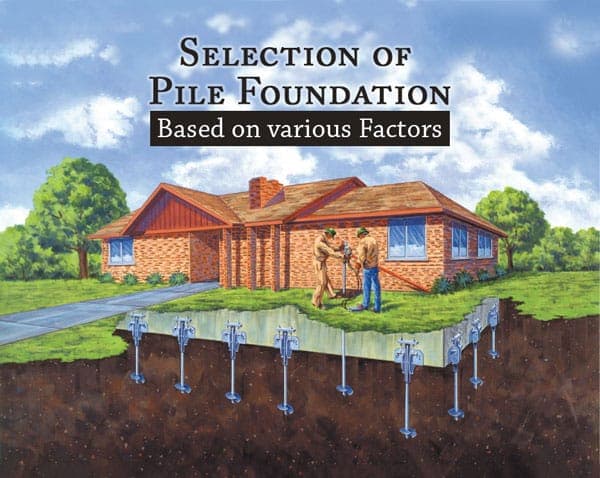
In one way, all buildings are stereotypes. Regardless their unique outlook, every building is built with the same components such as foundation, walls, floors and at least one roof. In addition to these basics, we commonly decorate them with plaster, paint etc. to add more aesthetics durability, and convenience for the users.
Every building is made of two basic and essential components. First is the foundation and the other is its superstructure. Let’s understand types of pile foundation and how to choose the right one.
Building Foundation: A Quick View
A building foundation is the base part of a building that bears the weight of the entire construction and transmits the load to underlying soil or rock. The building foundation can be classified as,
- Shallow foundation: A shallow foundation displays a typical depth, which is measured by counting the ground surface to the underside of the foundation, and the depth is calculated as lesser than five times of the total width of the foundation.
- Deep foundation: All other foundations other than shallow foundation are called deep
If the soil near the ground surface is not capable to support a building, deep foundations are required to transfer the loads to deep strata. Deep foundations are used when surface soil is not suitable for constructing a shallow foundation. The most common types of deep foundations are piles and caissons.
The pile foundations are one of the oldest methods of providing safe, sound, and dependable foundation. Pile foundations are required when,
- Upper soil strata are weak
- Presence of expansive soils, like black cotton soil is found in the construction site. This type of soil swells or shrinks as the water content of the soil gets frequently changed
- To resist horizontal forces in earth retaining tall structures
- Soil conditions are such that the risk of wash out, erosion or scour of soil may occur underneath a shallow foundation
A pile is a slender structural member made of timber, concrete or steel or combination of them. Piles are classified on the basis of their function or on the use and materials of its composition.
Based on the function the piles are classified as,
- End Bearing Piles
- Friction Piles
- Compaction Piles
- Tension Piles
- Anchor Piles
- Fender Piles
- Batter Piles
- Sheet Piles
Based on the materials and composition, piles are classified as,
- Concrete Piles
- Timber Piles
- Steel Piles
- Composite Piles
- Sand piles
Professional identification of the need for using piles and the selection of a specific type of pile foundation for a project are the integral part of the building design process. According to ‘Michael Tomlinson and John Woodward’ (Author of Pile Design and Construction Practice), the selection of an appropriate type of pile foundation is one of the most important design decisions and it is best made on the basis of experience in similar ground conditions.
The following factors should be considered at the time of selecting a type of pile foundation:
Factors for Selecting Types of Pile Foundation
01. Type of Structure
- The selection of the suitable type of pile foundation depends on the type of a structure i.e. if they are on-shore, off-shore or hydraulic structures, etc.
- For on-shore structures, the choice of driven and cast-in-situ piles is a wiser option. These piles are proven to be economical for a moderate loading pressure.
- For the foundations of the hydraulic structure category, the driven piles or cased cast-in-situ piles are more preferred.
- If piling is to be done near any existing structure, then open-ended tube piles or H-pile may be a better choice.
- Precast piles are preferred for marine structures or for the structures above the open water.
- The Jacked piles are suitable for the underpinning of an existing structures.
- For large structures, large diameter bored piles are the most economical option.
02. Loading Conditions
The selection of a particular type of pile depends on the nature and magnitude of the load. Following are the classifications of loads which are to be taken into account while designing the pile. For example, if
- Direct vertical load coming from the superstructure.
- Impact stresses developed during the pile driving.
- Stresses developing during handling of the operation.
- Bending stresses developed due to the curvature of the pile.
- Bending stresses developed due to the eccentricity of loads coming on the pile.
- Lateral forces generated due to the wind, waves, water currents, etc.
- Impact forces are experienced due to the ice sheets of barges.
- Impact forces are felt due to ships in case of off shore structures.
- Forces that are prevalent due to the uplift pressure.
- Seismic forces etc.
As per the ‘Satyendra Mittal’ (Author of Pile Foundation Design and Construction), for light loads, timber piles is a viable option. Alternatively, for heavier loads, the selection of steel or reinforced concrete pile is obviously a budget choice.
03. Ground Conditions
- A field test should be conducted before taking up the pile construction on site.
- The case study has to be carried out to identify the nature of soil from nearby locations or sites.
- The location of the water table should be studied carefully. The possible variations in water table during rainy and dry seasons should be considered at the time of designing the pile.
- If the groundwater flow is steady, pile with permanent casing is mostly used. Alternatively, precast piles are the better option.
- Driven piles are mostly found unaffected by groundwater, while in bored piles, concreting has to be carefully monitored when the construction work is ongoing against below-the water-table.
04. Load Carrying Capacity of Pile
- The detailed geotechnical investigation has to be done and load carrying capacity of pile has to be determined accordingly. This will vary with diameter and depth of pile and of course the carrying capacity of the foundation will depend on the various properties of soil along its depth.
Also Read:
6 Major Reasons for Failure of Pile Foundation
Soil Bearing Capacity: Definition and Ground Improvement Methods
05. Availability of Raw Materials
- The material used for the construction of piles are cement: furthermore, aggregates like fine aggregates, coarse aggregates, reinforcements, timber should be available at the site.
- These materials should comply with the provision of Indian standard codes.
06. Availability of Machinery
- The basic machine requirement will depend on the type of pile, its diameter, depth and soil type of the construction site.
- Several types of equipment are used for the construction of a pile foundation. Commonly used pile driving equipments required for pile foundation are pile frame, piling winch, Impact hammers like drop hammer, single and double acting steam hammer, diesel hammer, vibratory hammer, augur, under-reamer, boring guide, cutting tool, etc.
- At the time of selecting a type of pile foundation, it must be noticed that these tools are easily available and easy to maintain/repair.
Also Read:
Safety Measures while using Concrete Mixer at Site
40 + Masonry Tools Used in Masonry Work of Your Home!
07. Analysis of Cost
- If there are more than one options for the pile to be used for a given project, then approximate installing costs must be calculated and choose the most economical option of pile.
- Cost of pile load tests has to be added into the installation cost while calculating the overall cost.
- Maintenance cost must be included in calculation while analyzing the initial cost of pile foundation.
08. Availability of Funds
- There must be adequate availability of funds in order to construct a pile foundation.
Conclusion:
The function of any foundation is to safely sustain the load from the superstructure and transfer the load to the ground. The choice of any types of foundation depends on the intensity of load from superstructure, nature of subsoil, nature of superstructure etc. We must remember that in most of the cases, simple footings are the most economical foundation.
Deep foundation should be selected only when a shallow foundation is not a feasible option. In some cases, the soil improvement is done by applying various methods so that it becomes suitable for a shallow foundation.
Pile Foundation is preferred when there are excessive heavy gravity loads as well as lateral loads exerted over a weak soil. After considering all the factors discussed above it will be easier to select the right type of pile foundation.
Must Read:
7 Important Requirements that the Foundation System should Meet
Signs of Foundation Problems in Your House
What Should be the Minimum Depth of Foundation for New Home?
Image Courtesy – Image 1

































